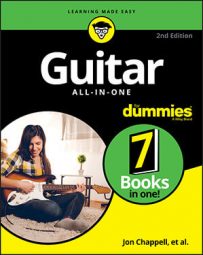If you’re just starting out as a novice guitarist, you may ask, “What’s the minimum I need to spend to avoid winding up with a piece of junk?” That’s a good question, because modern manufacturing practices now enable luthiers (the fancy term for guitar makers) to turn out some pretty good stuff for around $200 — and even less sometimes.
If you’re an adult and you’re looking to grow with an instrument, plan to spend between $200 and $250 for an acoustic guitar and a little less for an electric. (Electric guitars are a little easier to build than acoustics are, so they usually cost a bit less than comparable acoustics.) Not bad for something that can provide years of entertainment and help you develop musical skills, is it?
In trying to decide on a prospective guitar, consider the following criteria:
Appearance: You must like the way a particular guitar looks, or you’re never really happy with it. So use your eye and your sense of taste (your sense of aesthetics) to select possible candidates. A red guitar isn’t inherently better or worse than a green one, but you’re perfectly free to base your decision to buy simply on whether you like the look of the guitar.
Playability: Just because a guitar is relatively inexpensive doesn’t necessarily mean it’s difficult to play (although this correlation was often the case in the past). You should be able to press the strings down to the fretboard with relative ease. And you shouldn’t find the up-the-neck frets unduly difficult either, although they’re usually harder to play than the lower frets are.
Go back to that Ferrari — er, more expensive guitar — at the other end of the rack and see how a high-quality guitar plays. Then return to the more affordable instrument you’re considering. Is the playability wildly different? It shouldn’t be. If it doesn’t feel comfortable to you, move on.
Intonation: Besides being relatively easy to play, a guitar must play in tune. Test the intonation by playing a 12th-fret harmonic on the 1st string (place your finger lightly on the string at the 12th fret and pluck the string) and match that to playing the fretted note at the 12th fret. Although the notes are of a different tonal quality, the pitch should be exactly the same.
Apply this test to all six strings. Listen especially to the 3rd and 6th strings. On a guitar that’s not set up correctly, these strings are likely to go out of tune first. If you don’t trust your ears to tell the difference, enlist the aid of an experienced guitarist on this issue; it’s crucial.
Solid construction: If you’re checking out an acoustic, rap gently on the top of the instrument (like your doctor does to check your ribs and chest) to make sure it’s rattle free. Peer inside the hole, looking for gobs of glue and other evidence of sloppy workmanship. (Rough-sanded braces are a big tip-off to a hastily constructed instrument.)
On an electric, test that the metal hardware is all tightly secured and rattle free. Strum the open strings hard and listen for any rattling. Running your hand along the edge of the neck to check that the frets are smooth and filed correctly is another good test. If you’re not sure what you should be feeling, consult an experienced guitarist on this “fret check.”

